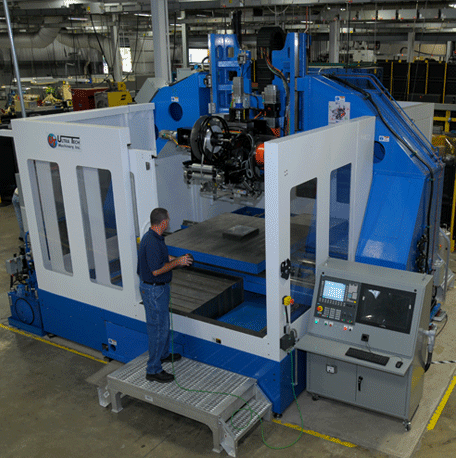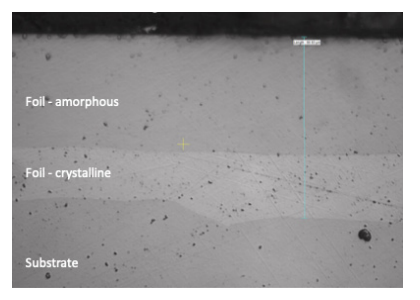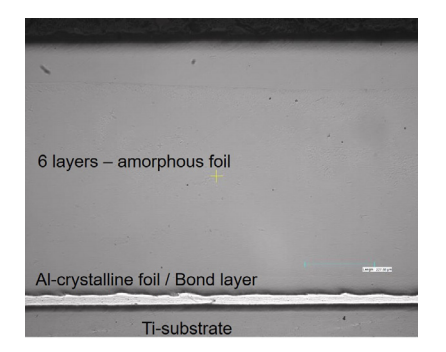Fabrisonic has always been a bit of an outlier in 3D print land. The company develops Ultrasonic Additive Manufacturing (UAM), which uses sound waves to join together layers of metal foil before CNC’ing the final part. It’s very different from mainstream 3D print technologies, but allows for the mixture of materials, production of gradient parts, and consistent part properties. Because there are also no lasers or hot chambers, you can embed sensors and other sensitive components on or in Fabrisonic parts, as well. It has always been a technology where the potential applications were so vast, yet so undefined, that it was difficult to judge how well it would fare. Now, the company has presented a method through which UAM can make wear-resistant surfaces out of Bulk Metallic Glasses.

Wear resistance is a huge opportunity and business whereby all manner of machinery, machine surfaces, and tools are coated or made to be wear resistant. The savings of extending the life of an expensive tool are enormous, not only on the cost of the item itself but also to the interruption of production or the higher need for service calls. Especially in capital goods, construction equipment, mining, and oil and gas, this is a huge application.
Traditionally you could have these coatings applied, with laser cladding and related DED technologies already used for wear resistance. Through these kinds of hardfacing processes, a tough layer of material is added to the material that makes up the rest of the tool usually through welding. Commonly materials such as Stellite, are used for this. Now, Fabrisonic is taking advantage of Bulk Metallic Glasses.

Here a crysyaline material is joined with amorphous alloys.
Bulk Metallic Glasses are also called amorphous metals and manufacturing goods made from them has traditionally been very expensive and tough to do. These materials are made through rapid cooling (1000°C per second) which makes them glass-like and amorphous because they can not form crystalized structures properly. This gives them properties such as ultra-high strength, high hardness or a high degree of flexibility at elevated temperatures. This Nature article is an excellent guide if you’d like to learn more. The bulk part comes from the fact that initially only thin layers could be made.
Developed in the 1990s through in-space manufacturing onboard the Space Shuttle these cutting edge materials are a real frontier and they could be used extensively in orthopedics or in aerospace. NASA’s Bulk Metallic Glasses gears project shows us that Bulk Metallic Glasses could be used to make lubricant-free gearboxes that can operate at –173 °C. Apple also has an exclusive license in perpetuity for one of these materials, Liquidmetal, for consumer electronics.

Here they demonstrate using an interlayer and a soft interlayer
What Fabrisonic did is essentially develop a cladding process for Bulk Metallic Glasses using their UAM technology. They found that their process let the cladding retain its strength while, “multiple amorphous alloy foils can be added to a structure to create a tailorable thickness and multiple passes can be carried out for scale-up to greater cladding thicknesses.” Room temperature metallic bonds were created in between the metal and the Bulk Metallic Glasses, leading to the “preservation of amorphous structure while gaining strength inherent in a true metallic bond.” They were also able to mix, layer by layer, Bulk Metallic Glasses with more ductile materials to increase overall ductility also.

Here we can see them tailoring properties as well as thickness. The substrate is Titanium.
The team also was able to increase the geometric freedom of Bulk Metallic Glass structures and produce a wider variety of shapes. If they can scale up this technology, then this would be huge news for Fabrisonic and partner Liquidmetal Holdings (LMGH), which has gotten several SBIR grants to develop abrasion resistant coatings. They themselves say that, “LMGH and Fabrisonic can provide products and services that are a generational leap ahead of the current state-of-the-art. Significant advantages in base material protection, service life extension and application efficiency increases, all provide an arsenal of market levers.”
It seems a bit optimistic, but, by applying such a revolutionary material to hardfacing applications, this is truly a big potential application for them. It could mean that their technology could have an immense application area. Furthermore, if the geometric freedom of their process is extensive, then we could see a lof of Bulk Metallic Glasses products emerge relatively quickly. Perhaps these companies really have a winner on their hands now with this application.
I must disclose a potential conflict of interest here as I am the owner of Bulkmetallicglasses.com 😛
Subscribe to Our Email Newsletter
Stay up-to-date on all the latest news from the 3D printing industry and receive information and offers from third party vendors.
You May Also Like
Gorilla Sports GE’s First 3D Printed Titanium Cast
How do you help a gorilla with a broken arm? Sounds like the start of a bad joke a zookeeper might tell, but it’s an actual dilemma recently faced by...
Nylon 3D Printed Parts Made More Functional with Coatings & Colors
Parts 3D printed from polyamide (PA, Nylon) 12 using powder bed fusion (PBF) are a mainstay in the additive manufacturing (AM) industry. While post-finishing processes have improved the porosity of...
$25M to Back Sintavia’s Largest Expansion of Metal 3D Printing Capacity Since 2019
Sintavia, the digital manufacturing company specializing in mission-critical parts for strategic sectors, announced a $25 million investment to increase its production capacity, the largest expansion to its operations since 2019....
Velo3D Initiates Public Offering in a Bid to Strengthen Financial Foundations and Drive Future Growth
Velo3D (NYSE: VLD) has been among a number of publicly traded 3D printing firms that have attempted to weather the current macroeconomic climate. After posting a challenging financial report for 2023,...































